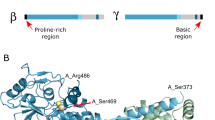Abstract.
Annexins comprise a unique family of calcium- and phospholipid-binding proteins. At least one of the twenty members thus far described from this family can be found expressed in nearly every eukaryotic cell type. As common as these proteins may be, no one clear function for all has been established. Historically, individual members of this family have been given various names describing their ability to associate with a host of intra- and extracellular proteins and with cellular lipid membranes. The collection of reviews in this issue of CMLS represents an effort to offer a coordinated view of the research activities in the field and to extract structural and functional commonalities.
Similar content being viewed by others
Author information
Authors and Affiliations
Rights and permissions
About this article
Cite this article
Mollenhauer, J. Annexins: what are they good for?. CMLS, Cell. mol. life sci. 53, 506–507 (1997). https://doi.org/10.1007/s000180050063
Issue Date:
DOI: https://doi.org/10.1007/s000180050063




